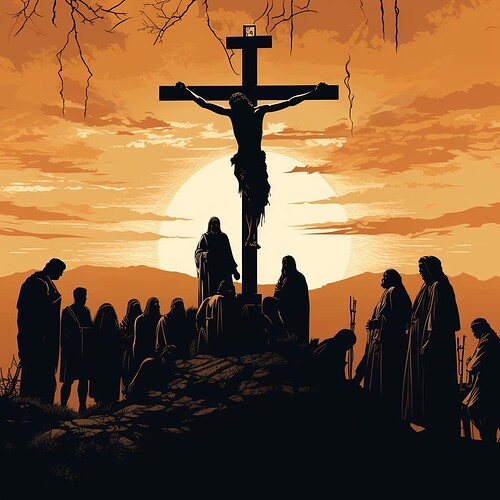 January 25: Matthew 27: The Crucifixion of Jesus
January 25: Matthew 27: The Crucifixion of Jesus
A Reflection on Sacrifice and Redemption
 Introduction
Introduction
Today, we delve into Matthew 27, a pivotal chapter in the New Testament, chronicling the crucifixion of Jesus Christ. This chapter confronts us with the intense moments leading to the crucifixion, the act itself, and its profound implications.
 Matthew 27: The Path to the Cross
Matthew 27: The Path to the Cross
Matthew 27 presents a harrowing narrative, starting with Jesus’ trial before Pilate, His crucifixion, death, and burial. This chapter is central to Christian faith, embodying the ultimate sacrifice for humanity’s redemption.
Key Verse: “When he had tasted it, he refused to drink it. After they had nailed him to the cross…” — Matthew 27:34-35
 Key Themes and Reflections:
Key Themes and Reflections:
Injustice and Betrayal: The chapter portrays the stark injustice and betrayal Jesus faced, highlighting His innocence amidst false accusations.
Sacrifice and Redemption: The crucifixion symbolizes the ultimate sacrifice for the sins of humanity, offering redemption and hope.
Strength in Suffering: Jesus’ endurance through suffering and His steadfast faith exemplify strength in adversity.
 Today’s Application:
Today’s Application:
Reflect on the significance of Jesus’ sacrifice. Contemplate the depth of love and commitment it represents and how it impacts our understanding of forgiveness and redemption.
 Hidden Gem:
Hidden Gem:
Did you know? The events in Matthew 27 fulfill several Old Testament prophecies, showcasing the coherence and continuity of biblical revelation.
 Reflective Q&A:
Reflective Q&A:
![]() Matthew 27: The Crucifixion
Matthew 27: The Crucifixion
![]() The Meaning of Sacrifice: What does Jesus’ crucifixion teach us about sacrifice and its role in our spiritual lives?
The Meaning of Sacrifice: What does Jesus’ crucifixion teach us about sacrifice and its role in our spiritual lives?
A: Jesus’ crucifixion exemplifies the profound nature of sacrifice – giving oneself for the greater good, and in His case, for the salvation of all. It teaches us about selflessness, love, and the power of sacrifice in bringing about transformation.
![]() Endurance in Suffering: How can Jesus’ endurance through suffering inspire us in our own struggles?
Endurance in Suffering: How can Jesus’ endurance through suffering inspire us in our own struggles?
A: Jesus’ endurance in the face of extreme suffering and injustice serves as a powerful example of faith and resilience. It encourages us to persevere in our trials, trusting in God’s purpose and presence even in our darkest hours.
 Join the Discussion:
Join the Discussion:
How does Matthew 27 affect your understanding of Jesus’ mission and its significance in Christian faith? Share your insights and reflections on this pivotal chapter.
#Crucifixion #JesusChrist #Sacrifice #Redemption #BibleStudy #FaithJourney
![]() See You Tomorrow in Matthew: Join us as we continue to explore the profound lessons and narratives in the Gospel of Matthew.
See You Tomorrow in Matthew: Join us as we continue to explore the profound lessons and narratives in the Gospel of Matthew.
 Join the forum!
Join the forum!
Participate in our AIgniteScripture Community for further exploration:
Free Members: Join vibrant discussions and access rich biblical resources at https://forum.aignitescripture.com/join.
Supporters Membership ($20/month or $200/year): Access personalized insights, newsletters, and exclusive forum content. Join as a Supporter at https://forum.aignitescripture.com/support.
![]() Stay Connected with our AIgniteScripture Newsletter: Don’t miss out on daily readings and insights. Subscribe at https://newsletter.aignitescripture.com/.
Stay Connected with our AIgniteScripture Newsletter: Don’t miss out on daily readings and insights. Subscribe at https://newsletter.aignitescripture.com/.
